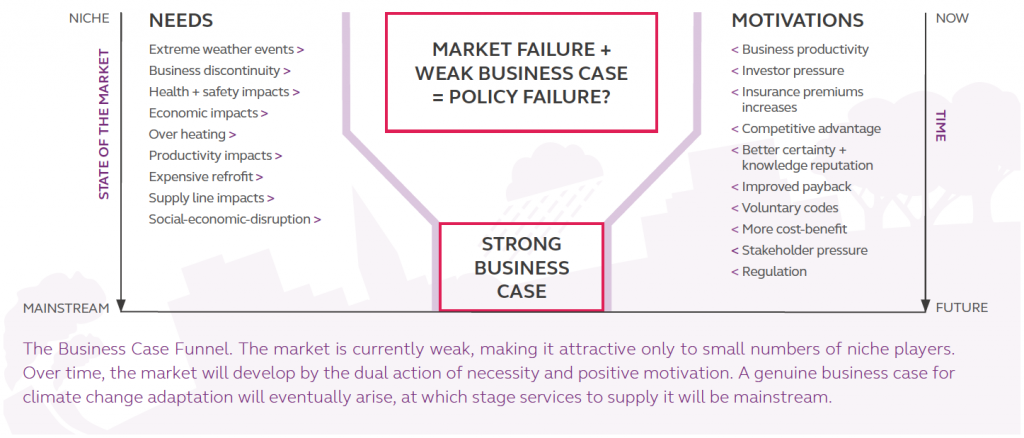
About the Author
Mark Wray
Lead Technologist – Built Environment, Innovate UK
“Warming of the climate system is unequivocal, as is now evident from observations of increases in global average air and ocean temperatures, widespread melting of snow and ice, and rising global average sea level”. Fourth Assessment Report from the UN Intergovernmental Panel on Climate Change (IPCC), 2007
The impact of climate change is particularly pertinent to the construction industry, for the simple reason that buildings last a long time. Our existing built environment, and every aspect of how we live our lives, has evolved in response to a particular climate. Now that our climate is changing, and may soon become significantly different, we are facing a real challenge.
Nevertheless, through these changes, the construction industry is being presented with an exceptional business opportunity to convert and upgrade our present urban fabric to function in a climate for which it was not designed. This will not only require the industry to pursue the now familiar low-energy, low-carbon design agenda that is already increasingly embedded in legislation, but to also recognize that it needs to look at the entire design concept in a fresh way so that it may adapt to higher summer temperatures and have the ability to cope with extreme weather events.
Innovate UK’s Design for Future Climate, Adapting Buildings (D4FC) [1] program has generated a substantial body of evidence for how different buildings exposed to different climate risks can best be adapted for a changing climate.
EXTREME WEATHER EVENTS AS TRIGGERS FOR POLICY CHANGE
HURRICANE SANDY
In October 2012, the deadly Hurricane Sandy affected many countries, including the U.S., with the economic damage caused amounting to $65bn. In New York, the storm surge flooded streets, tunnels and subway lines and cut power in and around the city.
This event has resulted in a comprehensive review of the building codes for New York City including practical guidance and new flood maps. It has also embraced working with nature, the success of which has been shown through the PlaNYC (the sustainability and resiliency blueprint for New York City) Initiative’s $2.4bn green infrastructure plan using natural methods of capturing rainwater before it can flood communities and overwhelm the sewage system.
As such, major developments should now be made in vulnerable areas in order to undertake climate risk assessments.
The policy impact of Sandy also spawned the Risky Business initiative to assess the national exposure to risk, an initiative now being backed by big-hitters in politics and finance.
WHAT CONSIDERATIONS ARE THERE?
This article is aimed mainly at building designers but also has sections that are directly relevant to construction clients and other stakeholders, and policy and regulation makers.
It explores the emerging market for building design services to prepare buildings for a changing climate across the globe. It considers the following important questions:
• Does preparing buildings for a changing climate make sense to construction clients?
• What kinds of clients are or ought to be interested?
• Can building designers exploit the opportunity?
• What building design competences are needed?
• How can climate change adaptation be mainstreamed in the built environment?
The technical challenge of adapting to future climate change in the built environment is to optimize building design now for the most effective phased transition to what will be needed in the future. Since the lives of buildings are measured in decades, this means anticipating the future and developing a gradual adaptation strategy that makes use of maintenance cycles for timely, effective and proportionate upgrades.
Unfortunately, the steps needed to assess the risks from climate change, and then to design appropriate responses, are complex and beset by uncertainty. Also, climate change risk is just one class among many risks affecting buildings.
Consideration of the impacts of future climate is new territory for both clients and the construction industry. It has the potential to radically alter the way we design, construct, use and adapt our buildings. As such, it could be a rich source of design inspiration as we develop elegant approaches to produce buildings that will be resilient in a future that is both certain (change is inevitable) and uncertain (the rate and magnitude of change is unclear), as well as meeting
the challenging mitigation targets necessary to avoid catastrophic change.
RECOMMENDATIONS
CLIENTS
Clients should adopt appropriate procurement strategies, and look to appoint competent building designers, in order to manage the risk from climate change.
Clients should collaborate with building designers to produce new advice for developing briefs that emphasize the needs of all financial stakeholders.
Construction client bodies, with the help of academic researchers and commercial suppliers to the industry, should develop construction client decision-making tools that accommodate future uncertainty.
BUILDING DESIGN PRACTICE
Professional institutions in the built environment should raise climate change adaptation up their list of priority concerns, and promote continuing professional development, lobbying, and advances in professional knowledge and codes of practice.
Professional institutions should update standard terms and conditions for professional contracts and project management practice to account for climate change adaptation services.
Industry should develop an authoritative index of climate readiness for buildings that allows clients to promote their buildings’ credentials.
Building design firms should incorporate the adaptation design process into their project management in the same way that tabs are kept on, for example, regulatory compliance or health and safety.
THE CONSTRUCTION INDUSTRY AS A WHOLE
Professional institutions in the built environment and academic researchers should develop a protocol for assessing the risk to buildings from climate change hazards.
Professional institutions in the built environment, academic researchers and commercial suppliers to the industry should:
• develop a method for valuing benefits with no monetary, value in an adaptation cost-benefit analysis
• develop computational tools to standardize the way that climate change projections can be used by building designers
• develop and maintain a simple set of ratios for different building types as a shorthand to understand the relationship between capital expenditure and operational
expenditure
REGULATION MAKERS
Avoiding completely new legislation, governments should coordinate the updating of standards, planning and building regulations to accommodate climate change adaptation.
Governments around the world should:
• maintain research into climate change to reduce the uncertainty of future climate impacts, particularly those aspects that affect the built environment
• support strategic action by industry to monitor, disseminate, and promote climate change adaptation information about the built environment to developers, clients, design professionals, constructors, facilities managers, and tenant organizations
• require public building procurement and maintenance regimes to consider future climate change and the development of buildings with adaptive capacity
In partnership with governments, industry should:
• establish a program of longitudinal demonstration projects, monitor their performance and publish the results openly
• establish a program of research to reduce the uncertainty of future climate impacts on the built environment at the local site-based scale
NEW BUSINESS COMPETENCES FOR BUILDING DESIGNERS?
Building designers should favor passive adaptation design measures to avoid compromising efforts to mitigate climate change. However, they should recognize that these may not be sufficient to cope with climate change from mid-century onwards when, for instance, active assistance may be needed for cooling.
The key deliverable from a climate change adaptation service is the phased adaptation plan. For maximum effectiveness, adaptation should be considered as early as possible in the project life.
There is no prescribed standard for climate change risk assessment, but Bill Gething’s adaptation matrices are nonetheless a useful basis for assessing buildings’ vulnerability to and risks from climate change [2]. Equally, the UK Climate Impacts Programme (UKCIP) Adaptation Wizard sets out a useful framework for building designers to develop adaptation strategies.
[1] www.gov.uk/government/publications/the-business-case-for-adapting-buildings-to-climate-change
[2] www.slideshare.net/WebadminTSB/design-for-the-future-report-june-2010
Further Information
For more information, contact:
Tel: +44 (0) 179 344 2700
Email: support@innovateuk.org
Twitter: @innovate_uk
Website: www.innovateuk.gov.uk

